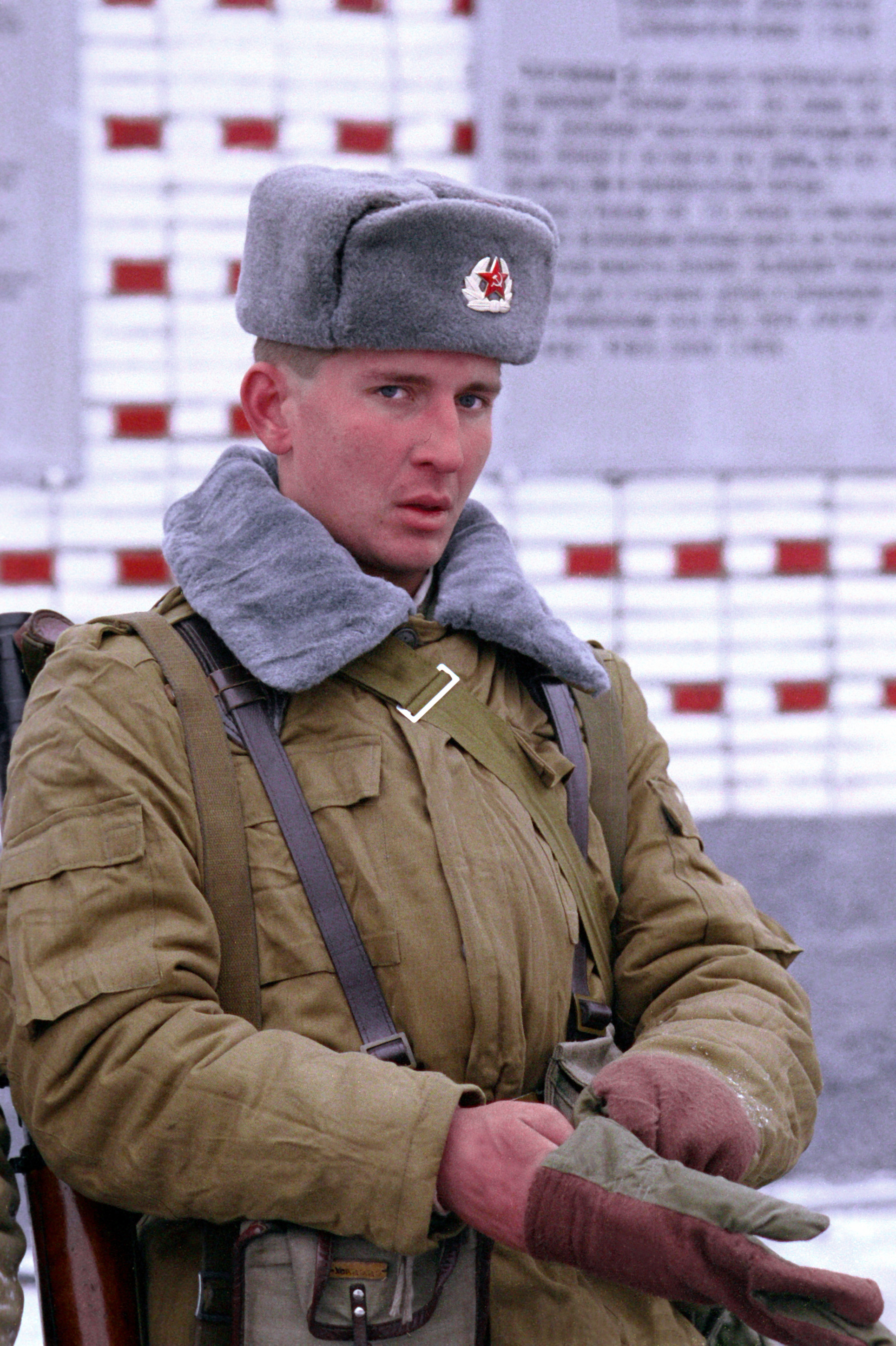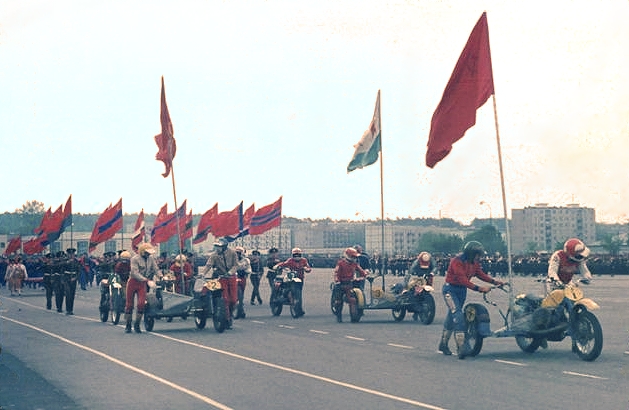|
442nd Missile Brigade
The 442nd Rocket Brigade was a Tactical ballistic missile brigade of the Soviet Army from 1987 to 1991. It was originally formed and based in Czechoslovakia with the Central Group of Forces but moved to Shuya, Ivanovo Oblast in 1990. The brigade was disbanded in 1991. History The 442nd Missile Brigade was formed in September 1987 in Hvězdov (part of Ralsko),{{Cite web, url=http://wpristav.ru/news/raketnyj_kompleks_tochka_u_ss_21/2014-08-17-5791, title=Ракетный комплекс "Точка - У" SS-21 (часть 2), website=wpristav.ru, language=Russian, trans-title=Rocket complex Tochka-U SS-21 (Part 2), access-date=2016-03-11 part of the Central Group of Forces. The brigade included the 404th, 440th and 535th Separate Missile Battalions, as well as a technical battery. The 404th had been transferred to the brigade from the 30th Guards Motor Rifle Division, the 440th from the 48th Motor Rifle Division and the 535th from the 15th Guards Tank Division. The brigade was eq ... [...More Info...] [...Related Items...] OR: [Wikipedia] [Google] [Baidu] |
Soviet Army
uk, Радянська армія , image = File:Communist star with golden border and red rims.svg , alt = , caption = Emblem of the Soviet Army , start_date = 25 February 1946 , country = (1946–1991)' (1991–1992) , branch = , type = Army , role = Ground warfare, Land warfare , size = 3,668,075 active (1991) 4,129,506 reserve (1991) , command_structure = , garrison = , garrison_label = , nickname = "Red Army" , patron = , motto = ''За нашу Советскую Родину!(Za nashu Sovetskuyu Rodinu!)''"For our Soviet Motherland!" , colors = Red and yellow , colors_label = , march ... [...More Info...] [...Related Items...] OR: [Wikipedia] [Google] [Baidu] |
Tactical Ballistic Missile
A tactical ballistic missile (TBM), or battlefield range ballistic missile (BRBM), is a ballistic missile designed for short-range battlefield use. Typically, range (aeronautics), range is less than . Tactical ballistic missiles are usually mobile to ensure survivability and quick deployment, as well as carrying a variety of warheads to target enemy facilities, assembly areas, artillery, and other targets behind the front lines. Warheads can include conventional high explosive, Chemical warfare, chemical, Biological warfare, biological, or nuclear warheads. Typically tactical nuclear weapons are limited in their total yield compared to strategic rockets. Design Tactical ballistic missiles fill the gap between conventional rocket artillery and longer-range short-range ballistic missiles. Tactical missiles can carry heavy payloads deep behind enemy lines in comparison to rockets or gun artillery, while having better mobility and less expense than the more strategic theatre mi ... [...More Info...] [...Related Items...] OR: [Wikipedia] [Google] [Baidu] |
Shuya, Ivanovo Oblast
Shuya ( rus, Шу́я, p=ˈʂujə) is the third largest town in Ivanovo Oblast, Russia; located on the Teza River. Population: History The first record of Shuya is dated by 1393. Since 1403, the area was held by a branch of the House of Suzdal, which got their name "Shuysky" after the town. In 1539, the town was sacked by Safa Giray of Kazan. In 1566, it was taken by Ivan the Terrible as his personal property into Oprichnina. In 1722, the town was visited by Peter the Great, who launched textile manufacturing there. Town status was granted to it in 1778. By the 19th century, Shuya was developed into a major flax-processing center, although it has been since superseded in importance by the neighboring town of Ivanovo. Administrative and municipal status Within the framework of administrative divisions, Shuya serves as the administrative center of Shuysky District,Law #145-OZ even though it is not a part of it.Law #145-OZ stipulates that the borders of the administrative dis ... [...More Info...] [...Related Items...] OR: [Wikipedia] [Google] [Baidu] |
Soviet Army
uk, Радянська армія , image = File:Communist star with golden border and red rims.svg , alt = , caption = Emblem of the Soviet Army , start_date = 25 February 1946 , country = (1946–1991)' (1991–1992) , branch = , type = Army , role = Ground warfare, Land warfare , size = 3,668,075 active (1991) 4,129,506 reserve (1991) , command_structure = , garrison = , garrison_label = , nickname = "Red Army" , patron = , motto = ''За нашу Советскую Родину!(Za nashu Sovetskuyu Rodinu!)''"For our Soviet Motherland!" , colors = Red and yellow , colors_label = , march ... [...More Info...] [...Related Items...] OR: [Wikipedia] [Google] [Baidu] |
Czechoslovakia
, rue, Чеськословеньско, , yi, טשעכאסלאוואקיי, , common_name = Czechoslovakia , life_span = 1918–19391945–1992 , p1 = Austria-Hungary , image_p1 = , s1 = Czech Republic , flag_s1 = Flag of the Czech Republic.svg , s2 = Slovakia , flag_s2 = Flag of Slovakia.svg , image_flag = Flag of Czechoslovakia.svg , flag = Flag of Czechoslovakia , flag_type = Flag(1920–1992) , flag_border = Flag of Czechoslovakia , image_coat = Middle coat of arms of Czechoslovakia.svg , symbol_type = Middle coat of arms(1918–1938 and 1945–1961) , image_map = Czechoslovakia location map.svg , image_map_caption = Czechoslovakia during the interwar period and the Cold War , national_motto = , anthems = ... [...More Info...] [...Related Items...] OR: [Wikipedia] [Google] [Baidu] |
Central Group Of Forces
The Central Group of Forces (Russian: Центральная группа войск) was a formation of the Soviet Armed Forces used to incorporate Soviet troops in Central Europe on two occasions: in Austria and Hungary from 1945 to 1955 and troops stationed in Czechoslovakia after the Prague Spring of 1968. History First formation After the end of the Second World War, the Soviet High Command (Stavka) reorganized its troops on the territories it liberated from the Nazi occupation and now occupied. Stavka Directive Nr 11097 on 10 June 1945 created several new formations, known as ''Groups of Forces'', equivalent to military districts but located outside the Soviet Union. The Central Group of Forces was created around that time from the 1st Ukrainian Front to control troops in Austria and Hungary, and did so from 1945 until 1955, when Soviet troops were withdrawn from Austria after the Austrian State Treaty was agreed. Its first commander was Marshal of the Soviet Union Iva ... [...More Info...] [...Related Items...] OR: [Wikipedia] [Google] [Baidu] |
Ralsko (Česká Lípa District)
Ralsko (german: Roll) is a town in Česká Lípa District in the Liberec Region of the Czech Republic. It has about 2,100 inhabitants. It comprises area of the former military training area with Hradčany Air Base. Because of the former military area, the town's municipal territory is the fourth largest in the country, after the cities of Prague, Brno and Ostrava. Administrative parts The town is made up of town parts and villages of Boreček, Horní Krupá, Hradčany, Hvězdov, Jabloneček, Kuřívody, Náhlov, Ploužnice and Svébořice. The municipal office is located in Kuřívody. Geography Ralsko is located about southeast of Česká Lípa and southwest of Liberec. It lies in the Ralsko Uplands. The town is named after the mountain Ralsko, which lies on the northern municipal border and is the highest point of Ralsko and of the entire Ralsko Uplands with an altitude of . The Ploučnice River shortly crosses the municipal territory in the northeast. There are several ponds ... [...More Info...] [...Related Items...] OR: [Wikipedia] [Google] [Baidu] |
30th Guards Motor Rifle Division
3 (three) is a number, numeral (linguistics), numeral and numerical digit, digit. It is the natural number following 2 and preceding 4, and is the smallest odd prime number and the only prime preceding a square number. It has religious or cultural significance in many societies. Evolution of the Arabic digit The use of three lines to denote the number 3 occurred in many writing systems, including some (like Roman and Chinese numerals) that are still in use. That was also the original representation of 3 in the Brahmic numerals, Brahmic (Indian) numerical notation, its earliest forms aligned vertically. However, during the Gupta Empire the sign was modified by the addition of a curve on each line. The Nāgarī script rotated the lines clockwise, so they appeared horizontally, and ended each line with a short downward stroke on the right. In cursive script, the three strokes were eventually connected to form a glyph resembling a with an additional stroke at the bottom: ३. ... [...More Info...] [...Related Items...] OR: [Wikipedia] [Google] [Baidu] |
15th Guards Tank Division
The 15th Guards Mozyr Red Banner Order of Suvorov Tank Division (15 ''gv. td'') () was a tank division of the Soviet Army during the Cold War that became part of the Russian Ground Forces after the dissolution of the Soviet Union. The division was initially stationed in Belarus postwar, but remained as part of the permanent Soviet garrison in Czechoslovakia after its participation in the 1968 Warsaw Pact invasion of Czechoslovakia. The division was withdrawn to Chebarkul when Soviet forces departed Czechoslovakia and disbanded the during force reductions of the 1990s. From 1968 the division headquarters Military Unit Number (V/Ch) was 58539. History The 12th Guards Mechanized Division was reorganized from the 15th Guards Mozyr Red Banner Order of Suvorov Cavalry Division in 1945–1946 at Brest, and became part of the 28th Army. In September 1954, the 12th Guards Mechanized Division and the 50th Guards Rifle Division as part of the 128th Rifle Corps participated in the To ... [...More Info...] [...Related Items...] OR: [Wikipedia] [Google] [Baidu] |
OTR-21 Tochka
OTR-21 ''Tochka'' (russian: оперативно-тактический ракетный комплекс (ОТР) «Точка» ("point"); en, Tactical Operational Missile Complex "Tochka") is a Soviet tactical ballistic missile. Its GRAU designation is 9K79; its NATO reporting name is SS-21 Scarab. It is transported in a 9P129 vehicle and raised prior to launch. It uses an inertial guidance system. The OTR-21 forward deployment to East Germany began in 1981, replacing the earlier Luna-M series of unguided artillery rockets. Description The OTR-21 is a mobile missile launch system, designed to be deployed along with other land combat units on the battlefield. While the 9K52 Luna-M is large and relatively inaccurate, the OTR-21 is much smaller. The missile itself can be used for precise strikes on enemy tactical targets, such as control posts, bridges, storage facilities, troop concentrations and airfields. The fragmentation warhead can be replaced with a nuclear, biological o ... [...More Info...] [...Related Items...] OR: [Wikipedia] [Google] [Baidu] |







